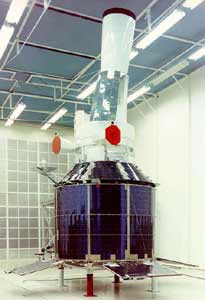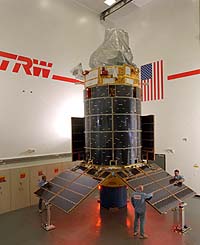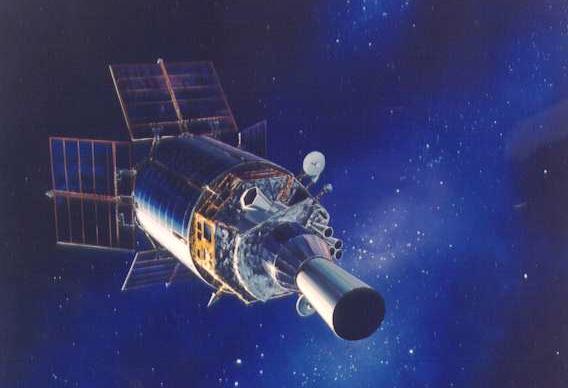TRW/AESC LS-3 DSP
The Integrated Missile Early Warning System (IMEWS) or Defense Satellite Program (DSP), was an operational system of military early warning satellites. Built by TRW, the satellites were equipped with television cameras and infrared sensors operating through a Schmidt telescope which was offset from the main axis of the telescope by 7.5° so that, with the satellite spinning at 6 rpm, a conical scanning pattern was achieved. Over several scans this allowed observers to distinguish between a stationary heat source, such as a forest fire, and a moving heat source, such as a missile.
Also known as Program 647 and LS-3A, the first generation of satellites is believed to have carried an array of 2000 infrared sensors whereas the second generation carried 6000 such sensors. The satellites are believed to have had a length of 7.01 m, a diameter of 2.78 m and a mass of 1100 kg. The operational system consisted of five satellites of which three were operational and two in-orbit spares. The locations which have been mentioned in subsequent reference sources included 36°W, 70°W, 85°W, 105°W, 134°W, 72°E and 75°E and it is suggested that satellites were periodically shifted to other locations.
 |
| Photo: Author's collection |
| LS-3A IMEWS-4 (1973-040A) |
IMEWS-10, IMEWS-11 and IMEWS-12 incorporated significant modifications to improve their performance and were designated as LS-3B.
 |
| Photo: Author's collection |
| LS-3B IMEWS-21 (2001-033A) |
The third generation, commencing with IMEWS-14 comprised nine satellites. They had a length of 10 m, a diameter of 4.15 m and a mass of 2500 kg. The operational system consisted of three satellites in geostationary orbit over the Atlantic, Pacific and Indian Oceans. The satellites were equipped with an improved telescope and 6000 infrared sensors with future versions having a capacity of 24,000 sensors. Some or all of the satellites in the series also carried a magnetospheric plasma analyser to measure low-energy ions and plasma, as well as a particle analyser, to measure energetic particles.
 |
| Image: USAF |
| LS-3B |
| Name | Intl. Designation | Launch | Notes |
|---|---|---|---|
| IMEWS-1 | 1970-093A | 6-Nov-1970 | Also known as OPS 5960; failed to achieve correct orbit |
| IMEWS-2 | 1971-039A | 5-May-1971 | Also known as OPS 3811 |
| IMEWS-3 | 1972-010A | 1-Mar-1972 | Also known as OPS 1570 |
| IMEWS-4 | 1973-040A | 12-Jun-1973 | Also known as OPS 6157 |
| IMEWS-5 | 1975-118A | 14-Dec-1975 | Also known as OPS 3165 |
| IMEWS-6 | 1976-059A | 26-Jun-1976 | Also known as OPS 2112 |
| IMEWS-7 | 1977-007A | 6-Feb-1977 | Also known as OPS 3151 |
| IMEWS-8 | 1979-053A | 10-Jun-1979 | Also known as OPS 7484 |
| IMEWS-9 | 1981-025A | 16-Mar-1981 | Also known as OPS 7350 |
| IMEWS-10 | 1982-019A | 6-Mar-1982 | Also known as OPS 8701 |
| IMEWS-11 | 1984-037A | 14-Apr-1984 | Also known as OPS 7641 |
| IMEWS-12 | 1984-129A | 22-Dec-1984 | Also known as USA 7 |
| IMEWS-13 | 1987-097A | 29-Nov-1987 | Also known as USA 28 |
| IMEWS-14 | 1989-046A | 14-Jun-1989 | Also known as USA 39 |
| IMEWS-15 | 1990-095A | 13-Nov-1990 | Also known as USA 65 |
| IMEWS-16 | 1991-080B | 25-Nov-1991 | Also known as USA 74 |
| IMEWS-17 | 1994-084A | 22-Dec-1994 | Also known as USA 107 |
| IMEWS-18 | 1997-008A | 24-Feb-1997 | Also known as USA 130 |
| IMEWS-19 | 1999-017A | 9-Apr-1999 | Also known as USA 142; failed to achieve correct orbit |
| IMEWS-20 | 2000-024A | 8-May-2000 | Also known as USA 149 |
| IMEWS-21 | 2001-033A | 6-Aug-2001 | Also known as USA 159 |
| IMEWS-22 | 2004-004A | 14-Feb-2004 | Also known as USA 176 |
| IMEWS-23 | 2007-054A | 11-Nov-2007 | Also known as USA 197 |
Launch dates of the IMEWS series
The launches of the last two IMEWS satellites, IMEWS-24 and -25, were cancelled.
Background
The primary objective of the early warning satellite development was to fill the gaps in the coverage provided by the land based Ballistic Missile Early Warning System utilised by the United States to provide an early detection of a missile attack. The system initially consisted of a chain of three large radar stations which observed the USSR.
MIDAS
The section on MIDAS has been removed. MIDAS is now covered in the article about WS-117L and its spin-offs.
Back to Directory of U.S. Military Rockets and Missiles, Appendix 3
Last Updated: 18 January 2008